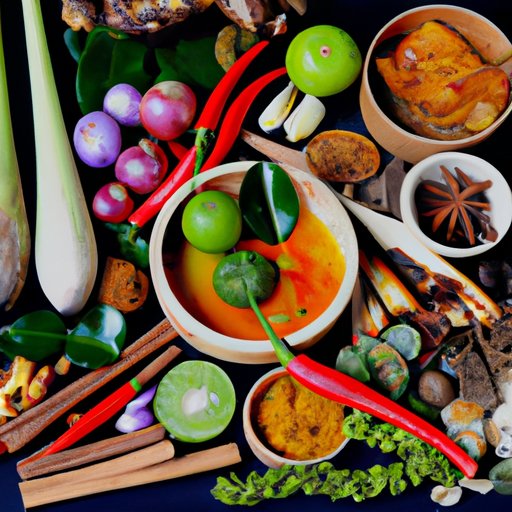Introduction
Are you looking for a flavorful and exciting way to spice up your meals? Thai curry is an excellent choice! This traditional and popular dish from Thailand comes in many different types and flavors, each one offering its own unique taste. In this article, we will explore how to eat Thai curry, from understanding the basics to gathering ingredients and even serving accompaniments.
Understand the Basics of Thai Curry
Thai curry is a rich and flavorful dish that can be made with a variety of meats, vegetables, and spices. It typically consists of a combination of coconut milk, lemongrass, galangal, kaffir lime leaves, fish sauce, and chili peppers. Depending on the type of curry, it may also include other ingredients such as tamarind, shrimp paste, or turmeric. There are several different types of Thai curry, each with its own unique flavor profile.
The most popular types of Thai curry are red, yellow, and green. Red curry is the spiciest of the three, with a deep red color and robust flavor. Yellow curry is milder and slightly sweeter than red curry, while green curry is the mildest and has an herby, citrusy flavor. Other popular types of curry include massaman curry, panang curry, and pineapple curry.
Choose a Variety
Once you understand the basics of Thai curry, it’s time to choose a variety that best suits your tastes. If you’re new to Thai cuisine, it’s a good idea to sample different types of curry to find out which one you like best. You can either order some at a local Thai restaurant, or if you’re feeling adventurous, try making them at home using a store-bought curry paste.
If you’re making your own curry at home, there are several different types of curry paste available in stores. For example, red curry paste is made with red chilies, galangal, lemongrass, garlic, shallots, and shrimp paste, while yellow curry paste is made with yellow chilies, turmeric, cumin, coriander, and lime leaves. Green curry paste is made with green chilies, lemongrass, ginger, garlic, and kaffir lime leaves.
Gather Your Ingredients
Now that you’ve chosen a type of curry, it’s time to gather your ingredients. The ingredients you’ll need will depend on the type of curry you’re making, but generally speaking, you’ll need some type of meat or vegetable, coconut milk, curry paste, and a variety of herbs and spices. Some recipes also call for fish sauce, tamarind paste, and palm sugar.
When shopping for ingredients, look for high-quality ingredients. Fresh herbs and spices will give your curry the best flavor, so try to buy organic whenever possible. If you’re short on time, you can also use pre-made curry pastes instead of making your own.
Prepare the Curry Paste
If you’re making your own curry paste, you’ll need to prepare it before you start cooking. To make a basic curry paste, you’ll need red chilies, lemongrass, galangal, garlic, shallots, and shrimp paste (or a vegetarian alternative). Start by blending the chilies, lemongrass, and galangal in a food processor until they form a paste. Next, add the garlic and shallots and blend until everything is combined. Finally, add the shrimp paste (if using) and blend until smooth.
Once you’ve prepared the curry paste, it’s ready to use. You can store it in the refrigerator for up to a week or freeze it for up to two months.
Cook the Curry
Once you have all your ingredients and curry paste ready, it’s time to cook the curry. Start by heating some oil in a large pot over medium heat. Add the curry paste and cook, stirring often, for about 5 minutes. Then add the coconut milk and any additional ingredients, such as vegetables or meat, and bring to a boil. Reduce the heat and let the curry simmer for about 15 minutes, or until the vegetables or meat are cooked through.
When the curry is finished cooking, season with salt and pepper to taste. Serve hot with your favorite accompaniments.
Serve with Accompaniments
To really bring out the flavor of the curry, serve it with a few accompaniments. Jasmine rice is a classic accompaniment to Thai curry, as it helps balance out the spicy flavors. You can also serve the curry with steamed vegetables, such as broccoli, carrots, or bell peppers. For a more filling meal, serve the curry with noodles or a side of roasted potatoes.
Another great accompaniment to Thai curry is pickled vegetables. Pickling vegetables adds a sour, salty flavor that complements the spicy flavors of the curry. You can make your own pickled vegetables at home, or you can buy them at the store.
Enjoy!
Now that you know how to eat Thai curry, it’s time to enjoy the unique flavors of this traditional dish. Whether you make your own curry paste or buy it from the store, you can be sure that your homemade Thai curry will be full of flavor and sure to please.
Conclusion
Thai curry is an incredibly flavorful and versatile dish that can be enjoyed for lunch, dinner, or even as a snack. With its complex mix of spices, herbs, and other ingredients, it’s no wonder why this traditional dish is so popular around the world. By following these steps, you’ll be able to enjoy the unique flavors of Thai curry with ease.
From understanding the basics to gathering ingredients and preparing the curry paste, you’ll be able to make a delicious curry in no time.
(Note: Is this article not meeting your expectations? Do you have knowledge or insights to share? Unlock new opportunities and expand your reach by joining our authors team. Click Registration to join us and share your expertise with our readers.)
